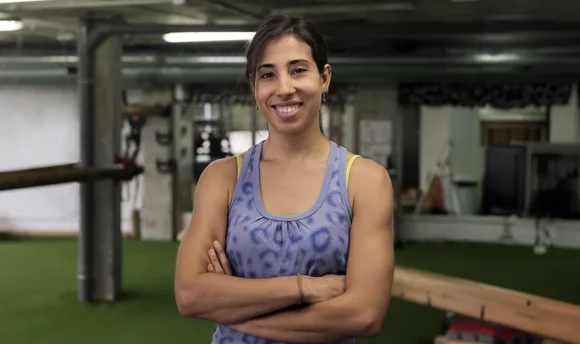How Long Does It Take for HIIT Results?
Knowing when to expect results from your workout is a good way to keep yourself motivated. Today, we discuss how long your high-intensity interval training takes to see results. Stay with us!

HIIT (high-intensity interval training), just like moderate-intensity continuous training, has slowly gained ground in the fitness world. If you are bound by time constraints but still seek an exercise routine that will lead to some severe burns, then HIIT is for you.
The reason for this is that HIIT is extremely efficient in helping people achieve their fitness goals, whether that centers on weight loss, toning muscles, improving endurance, developing strength, and many more.
Still, the question most people want to be answered is: how long does it take to see results? We have all the answers – and we want to help you find out. Today’s article discusses how long the results would take, what to expect, and ways to improve your exercise program.
Without further ado, let us get into it.
How Long Does It Take for HIIT Results?
There are 2 parts to gaining from doing high-intensity interval training. First, if your goal is to improve VO2 max and cardiovascular fitness, then 6–8 weeks of consistent HIIT workouts is your benchmark.
On the other hand, HIIT workouts will contribute to fat loss, but the results and their time frame depend on your ability to maintain a calorie deficit. One excellent way to maintain a calorie deficit and lose fat is by following the keto diet. It puts you on a strict nutrition regimen, which helps reduce body fat and promote weight loss.
However, other factors contribute to getting significant results from your HIIT workouts, whether you seek to build muscle mass, burn fat, lose weight, or stop cardiovascular or metabolic diseases.
These variables include the intensity of the workout program, number of HIIT sessions, rest routine, dietary habits, supplemental exercises, current fitness level, etc. In any sense, personalize each of these variables when creating a workout program.
How Long Should a HIIT Workout Be?
According to research by the American College of Sports Medicine (ACSM), a typical HIIT workout (work and rest intervals) lasts anywhere from 20 to 60 minutes.
Nonetheless, the length of your HIIT workout is a function of your personal goals and current fitness level. Beginners would want to take things a bit easier by engaging in a workout program that contains identical work and rest periods. That way, they do not overwork their bodies and risk overuse injuries.
An excellent example would be a workout program that revolves around 30 seconds of work and rest time.
Likewise, more advanced persons benefit more when their work periods are greater than their rest periods significantly. Since their fitness levels allow them to partake in an extended exercise routine, they are not at risk of overuse injuries as their newer counterparts.
In regards to that, their workout routine would combine 30 seconds of work with a shorter 15 seconds of rest.
Still, we must reiterate that HIIT workouts will differ amongst individuals. It is also asinine to think that you must exercise to the maximum for each of your work intervals. Even 5 minutes of interval training is enough to transform your health and physique.
How Often Should I Do HIIT Workouts?
There is no standard benchmark for how often you need to engage in high-intensity training. However, for the most part, an intense exercise routine 2–3 times weekly is a reasonable target to meet.
Whether you want to improve your cardiovascular fitness, burn body fat, build lean muscle mass, or prepare for a professional racing event. However, penciling rest days between your HIIT sessions will stop your body from breaking down and lead to faster results.
Regardless, on a more structured setup, those new to HIIT training should start with one day and see how their bodies respond to the intensity before any workout adjustment.
If they cannot handle the intensity, they are better off sticking to the one-day schedule or base training before any changes to their HIIT workout plan.
More advanced individuals are free to train three to six times weekly, with a mandatory rest day. But, again, that is because their bodies are able to handle the strain better.
You must remember that having such a rigorous routine (exercising every three times weekly) takes its toll on your body. As much as it offers a plethora of health gains, intense fatigue, increased inflammation, and running-related injuries are frequent happenings.
Those who need to exercise caution include people recovering from injuries, pregnant, deconditioned, overweight, and with underlying medical conditions.
Overall, these exercises are somewhat perfect – they have all the necessities – compared to other forms of exercise. Still, it would be best to structure your exercise regimen based on your capabilities and fitness goals.
3 Ways to Increase HIIT Results
It is difficult for most people to contend with the results of their HIIT workouts, as everyone is constantly seeking ways to better themselves; as such, finding a new way to improve your workout is a welcomed idea globally.
That is why we have put together three foolproof ways to increase your HIIT results. Take a look.
#1 Quality over quantity
While exercise frequency and duration are extremely vital to your HIIT program’s success, you must also learn how to exercise right. By that, we mean consciously prioritizing exercise quality over quantity.
You must actively learn how to do your workout, whether you prefer weight-based or bodyweight exercises, and what intensity to exercise at, as that will surely guarantee you positive results in no time.
Sure enough, if you are doing your exercise using the correct form and range of motion while allowing the right intensity, you are well in line to shorten your exercise frequency without a drop in performance.
In line with that, research delineates that your exercise performance should be between 80 and 95% of your maximum heart rate.
To get the figures, you can either calculate them manually or use a heart monitor.
#2 HIIT intensity
The intensity level of your HIIT workout is as important as any other influencing factor, especially when it comes to losing weight. After all, the word intensity is penciled into the name of the workout, hinting that it is a prerogative for the exercise.
Still, the level of intensity of any high-intensity exercise will depend on the abilities of the person partaking in it. Regardless of this fact, going as hard as possible will always yield positive results. On the other hand, developing this habit could see you tapping out after just 15 minutes of exercise.
Still, a gradual increase in your exercise intensity over several workout sessions is in order. Doing so prevents stagnation, which can negatively affect growth and performance.
#3 Consistent HIIT schedule
Consistency is the chief principle of any workout regimen. As such, it would be best if you structure your workout program to resonate with your goals.
Likewise, sticking to your routine will yield results regardless of how challenging training days are becoming.
As for a potential training schedule, you should schedule your typical HIIT training sessions at least twice a week. You can incorporate other exercise programs to fill up your week, with a mandatory rest day in-between hard workouts.
That way, your body gets to recover from all the beat-down, and the results unravel.
What Results Can You Be Expecting After 1 Month of HIIT Training?
For most people, 30 days of consistent exercising still feels like a short time to see the sort of results they imagine. However, their doubts grow even more when it comes to HIIT results since they may be unable to go as hard as they want due to the nature of the exercise.
Regardless, sports medicine affirms that HIIT workouts dramatically improve overall fitness as long as you possess the proper habits.
In essence, you will notice major changes in both body composition and exercise performance post one month of HIIT training. You will be able to complete subsequent workouts in less time, and the extra energy will transition into your mundane life.
We have put together a collection of some HIIT results you can expect from your month-long training.
#1 Increased VO2 max
VO2 max is a measure of the maximum amount (volume) of oxygen your body can consume while you exercise with a hard effort. It is based on a couple of factors, such as capillary density, mitochondrial density, and the volume of blood pumped by the heart.
During the one-month timeframe, going over a few HIIT workouts on a consistent basis will increase your VO2 max by about 8%. That is because your VO2 max begins to develop when you approach 70% of your maximal heart rate, making HIIT the perfect means to improve on it compared to more moderate-intensity work.
Because your cardiovascular system can deliver more oxygen to your muscles, you can engage in strenuous exercise for extended periods of time. Long-distance runs, hill training, sprints, and other exercises become easier as a result.
#2 Endurance
Having a boatload of endurance to spare is always a blessing for those who engage in strenuous activities. To get more endurance, you have to train for it. There are no two ways about it.
HIIT workouts are well-suited for increasing your endurance pool, and you will surely attest to that after completing your month-long exercise routine. That is because it increases oxygen intake while boosting muscular and metabolic adaptations.
#3 Toned muscles
Although HIIT workouts are not the best method to build lean muscle mass, the ability to retain lean muscle is good. Simply doing a series of bodyweight exercises will produce positive results.
You can modify it to target any muscle group you choose. You get the best results, which happen to be toned, defined muscles.
#4 Weight loss
Most people who partake in any form of exercise have fat burning and weight loss as major motivation sources. However, relevant studies show that partaking in high-intensity interval training is a more effective means of inducing weight loss than steady-state cardio.
That is primarily because high-intensity aerobic training increases the human musculoskeletal system’s fat and carbohydrate metabolic capacities.
To put it simply, HIIT workouts force your body to use fat instead of carbs in energy production. So, when paired with the proper diet, you will be able to burn a significant amount of calories and maintain a calorie deficit, fuel body fat reduction, and lose body weight.
The best part about weight loss and HIIT training is that you do not have to train for prolonged periods before seeing visible results. According to research, you will see positive weight loss results two weeks into your training program.
The workout routine in the research centered on 4–7 cycling reps at hard effort (each rep lasting 30 seconds) followed by 4 minutes of rest (cycling at a lower intensity). The result obtained revealed an increased muscle oxidative potential and cycle endurance capacity.
Remember – Perfect Body Doesn’t Exist
One of the major selling points with HIIT is the after-burn effect. The fact that your body continues to work despite concluding your HIIT training program drives many people into the exercise, hoping that they can alter their body composition over time.
However, the truth remains absolute: there is no perfect body. If there is any area of your body that you are unsatisfied with, you have the liberty of training that area, but eliminating misproportion is highly improbable.
A Word From Our Coach
HIIT is an excellent workout program that leads to many net positive health benefits. Yes, you may not be able to grow big muscles, but you can easily burn calories, lose fat, improve the cardiorespiratory system, and build endurance.
Coupled with the fact that you can easily incorporate them into any routine, it is a win-win situation.
Again, you must check in with a certified clinical exercise physiologist before engaging in high-intensity interval training or vigorous exercise.
Conclusion
HIIT training is a challenging training program for anybody. Nonetheless, the benefits make it worth the stress.
Still, you must listen to your body. Your body can only go so far before it eventually succumbs to stress. To counter this, make sure you take rest days, eat healthily, and avoid over-training.
Other than that, have fun with your workout. The results will come in eventually!

















































 Select your language:
Select your language: 








